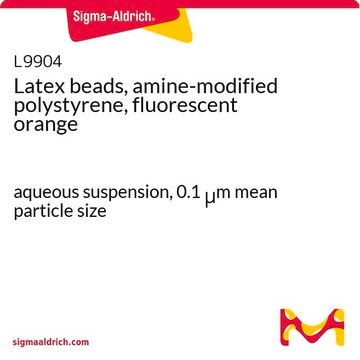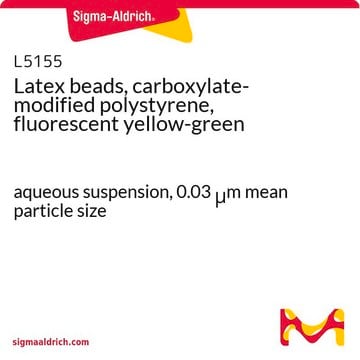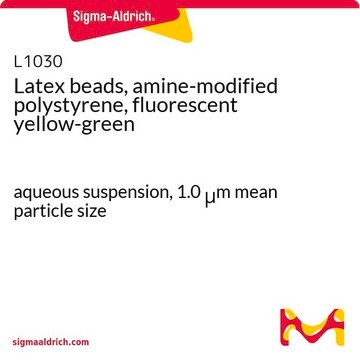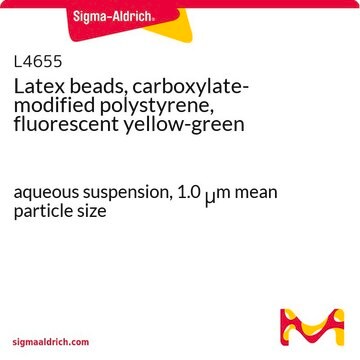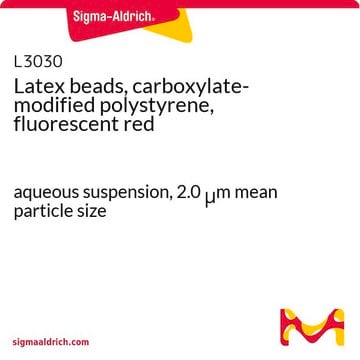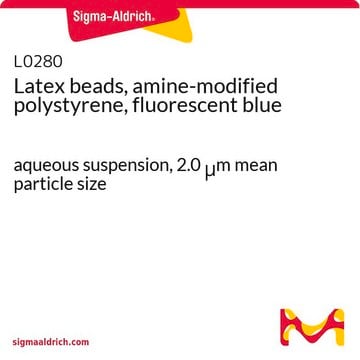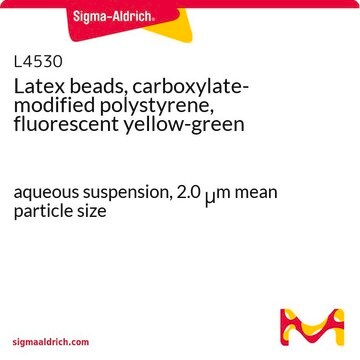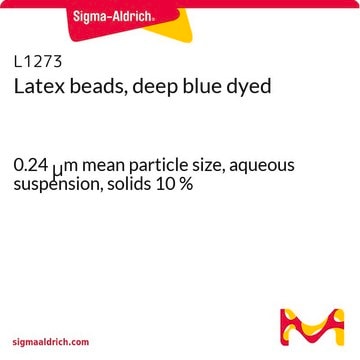L0780
Latex beads, amine-modified polystyrene, fluorescent blue
aqueous suspension, 0.05 μm mean particle size
Sign Into View Organizational & Contract Pricing
All Photos(1)
About This Item
Recommended Products
form
aqueous suspension
composition
Solids, 2.5%
technique(s)
cell based assay: suitable
mean particle size
0.05 μm
fluorescence
λex ~360 nm; λem ~420 nm
application(s)
cell analysis
Looking for similar products? Visit Product Comparison Guide
Application
Latex beads, amine-modified polystyrene, fluorescent blue has been used:
- to study its effects on the concentration-response relationship of bacterial cell viability
- in the preparation of nanoparticles
- as a model nanoparticle to study interactions with human blood and platelets
Biochem/physiol Actions
Polystyrene latex beads can be used to create latex agglutination systems. Polystyrene latex beads have been used to study the transmission of Mycobacterium leprae, the causative pathogen of leprosy, as well as to develop a method for mass screening for both pulmonary and extrapulmonary tuberculosis.
Storage Class Code
10 - Combustible liquids
WGK
WGK 3
Flash Point(F)
Not applicable
Flash Point(C)
Not applicable
Certificates of Analysis (COA)
Search for Certificates of Analysis (COA) by entering the products Lot/Batch Number. Lot and Batch Numbers can be found on a product’s label following the words ‘Lot’ or ‘Batch’.
Already Own This Product?
Find documentation for the products that you have recently purchased in the Document Library.
Customers Also Viewed
INDUCTION OF EPIGENETIC RESPONSE TO AMINO-MODIFIED POLYSTYRENE NANOPARTICLES IN HUMAN CELLS
Koprinarova M, et al.
Comparative clinical pathology, 71(10) (2018)
Catherine McGuinnes et al.
Toxicological sciences : an official journal of the Society of Toxicology, 119(2), 359-368 (2010-12-03)
There is evidence that nanoparticles (NP) can enter the bloodstream following deposition in the lungs, where they may interact with platelets. Polystyrene latex nanoparticles (PLNP) of the same size but with different surface charge-unmodified (umPLNP), aminated (aPLNP), and carboxylated (cPLNP)-were
J Geys et al.
Toxicology letters, 160(3), 218-226 (2005-09-03)
Recent studies indicate that inhaled ultrafine particles can pass into the circulation. To study this translocation in an in vitro model three types of pulmonary epithelial cells were examined. The integrity of the cell monolayer was verified by measuring the
Optical signatures of small nanoparticles in a conventional microscope.
Eann A Patterson et al.
Small (Weinheim an der Bergstrasse, Germany), 4(10), 1703-1706 (2008-09-10)
J-M Gineste et al.
Journal of microscopy, 243(2), 172-178 (2011-03-08)
The forward scattering of light in a conventional inverted optical microscope by nanoparticles ranging in diameter from 10 to 50nm has been used to automatically and quantitatively identify and track their location in three-dimensions with a temporal resolution of 200ms.
Our team of scientists has experience in all areas of research including Life Science, Material Science, Chemical Synthesis, Chromatography, Analytical and many others.
Contact Technical Service
